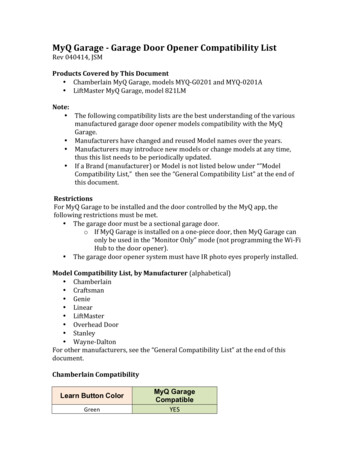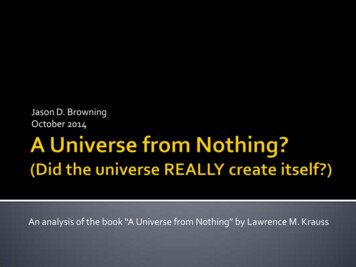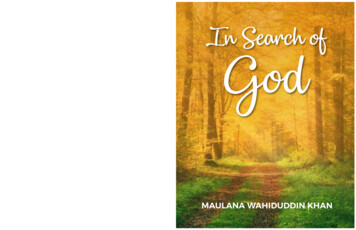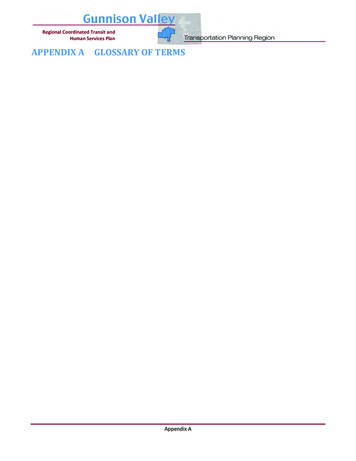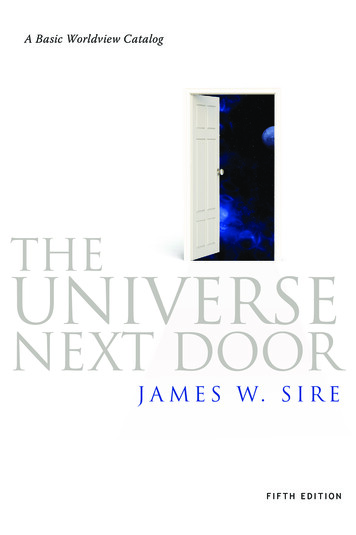
Transcription
A Basic Worldview CatalogTheUniverseNext DoorJ a m e s W. S i r eFifth Edition
For any of us to be fully consciousintellectually we should not only be ableto detect the worldviews of othersbut be aware of our own—why it is ours and why in light of so many optionswe think it is true.
Other Books by James W. SireHow to Read SlowlyScripture TwistingBeginning with GodDiscipleship of the MindChris Chrisman Goes to CollegeWhy Should Anyone Believe Anything at All?Jesus the Reason (Bible study guide)Habits of the MindVáclav HavelNaming the ElephantWhy Good Arguments Often FailLearning to Pray Through the PsalmsA Little Primer on Humble ApologeticsPraying the Psalms of JesusDeepest Differences with Carl Peraino
A Basic Worldview CatalogTHEUNIVERSENEXT DOORJ A M E S W. SI R EFIFTH EDITION
InterVarsity Press, USAP.O. Box 1400, Downers Grove, IL 60515-1426, USAWorld Wide Web: www.ivpress.comEmail: email@ivpress.comFifth edition 2009 by James W. Sire. First edition 1976 by Inter-Varsity Christian Fellowship of the UnitedStates of America. Second edition 1988 by James W. Sire. Third edition 1997 by James W. Sire. Fourth edition 2004 by James W. Sire.All rights reserved. No part of this publication may be reproduced, stored in a retrieval system or transmitted inany form or by any means, electronic, mechanical, photocopying, recording or otherwise, without the priorpermission of InterVarsity Press.InterVarsity Press , USA, is the book-publishing division of InterVarsity Christian Fellowship/USA , a movementof students and faculty active on campus at hundreds of universities, colleges and schools of nursing in the UnitedStates of America, and a member movement of the International Fellowship of Evangelical Students. Forinformation about local and regional activities, write Public Relations Dept., InterVarsity Christian Fellowship/USA, 6400 Schroeder Rd., P.O. Box 7895, Madison, WI 53707-7895, or visit the IVCF website at www.intervarsity.org .All Scripture quotations, unless otherwise indicated, are taken from the Holy Bible, New International Version .NIV . Copyright 1973, 1978, 1984 by International Bible Society. Used by permission of Zondervan PublishingHouse. Distributed in the U.K. by permission of Hodder and Stoughton Ltd. All rights reserved. “NIV” is aregistered trademark of International Bible Society. UK trademark number 1448790.Design: Cindy KipleImages: deep space: Phil Morley/iStockphotoopen door: Nicolas Loran/iStockphotoISBN 978-0-8308-7742-3 (digital)ISBN 978-0-8308-3850-9 (print)
To MarjorieCarol, Mark and CalebEugene and LisaRichard, Kay Dee, Derek, Hannah, Micah, Abigail and JoannaAnn, Jeff, Aaron and Jacobwhose worlds on worldscompose my familiar and burgeoning universe
CON T EN TSPreface to the Fifth Edition . . . . . . . . . . . . . . . . . . . .1A World of Difference: Introduction. . . . . . . . . . . . .2A Universe Charged with the Grandeur of God:915Christian Theism . . . . . . . . . . . . . . . . . . . . . . . . . .253The Clockwork Universe: Deism. . . . . . . . . . . . . . .474The Silence of Finite Space: Naturalism . . . . . . . . . . .665Zero Point: Nihilism . . . . . . . . . . . . . . . . . . . . . . . .946Beyond Nihilism: Existentialism . . . . . . . . . . . . . . . . .1177Journey to the East: Eastern Pantheistic Monism. . . . . . 1448A Separate Universe: The New Age—SpiritualityWithout Religion . . . . . . . . . . . . . . . . . . . . . . . . . . . 1669The Vanished Horizon: Postmodernism . . . . . . . . . . . .21410A View from the Middle East: Islamic Theism. . . . . . .24411The Examined Life: Conclusion. . . . . . . . . . . . . . . . .278Index. . . . . . . . . . . . . . . . . . . . . . . . . . . . . . . . . . . .287
PR EFACE TOTHE FIF TH EDITIONIt has been more than thirty-three years since this book was firstpub lished in 1976. Much has happened both in the development of worldviews in the West and in the way others and I have come to understandthe notion of worldview.In 1976 the New Age worldview was just forming and had yet to begiven a name. I called it “the new consciousness.” At the same time theword postmodern was used only in academic circles and had yet to berecognized as an intellectually significant shift. Now, in 2009, the NewAge is over thirty years old, adolescent only in character, not in years.Meanwhile postmodernism has penetrated every area of intellectual life,enough to have triggered at least a modest backlash. Pluralism, and therelativism and syncretism that have accompanied it, have muted the distinctive voice of every point of view. And though the third edition of thisbook noted these, there is now more to the stories of both the New Ageand postmodernism. In the fourth edition I updated the chapter on theNew Age and substantially revised the chapter on postmodernism.In the fourth edition I also reformulated the entire notion of worldview. What is it, really? There have been challenges to the definition Igave in 1976 (and left unchanged in the 1988 and 1997 editions). Was itnot too intellectual? Isn’t a worldview more unconscious than conscious?Why does it begin with abstract ontology (the notion of being) instead ofthe more personal question of epistemology (how we know)? Don’t wefirst need to have our knowledge justified before we can make claimsabout the nature of ultimate reality? Isn’t my definition of worldview de-
10The Universe Next Doorpendent on nineteenth-century German idealism or, perhaps, the truthof the Christian worldview itself? What about the role of behavior informing or assessing or even identifying one’s worldview? Doesn’t postmodernism undermine the very notion of worldview?I took these challenges to heart. The result was twofold. First was thewriting of Naming the Elephant: Worldview as a Concept, published atthe same time as the fourth edition of The Universe Next Door. Here Iaddressed a host of issues surrounding the concept of worldview. Readerswho are interested in the intellectual tool used in the fourth edition andthis one will find it analyzed at much greater depth there. To do this, Iwas greatly aided by the work of David Naugle, professor of philosophy atDallas Baptist University. In Worldview: The History of a Concept he surveyed the origin, development and various versions of the concept fromImmanuel Kant to Arthur Holmes and beyond, and he presents his owndefinition of the Christian worldview. It is his identification of worldviewwith the biblical notion of the heart that has spawned my own reviseddefinition, which appears in chapter one of the fourth edition and thepresent book.Readers of any of the first three editions will note that the new definition does four things. First, it shifts the focus from a worldview as a “setof presuppositions” to a “commitment, a fundamental orientation of theheart,” giving more emphasis to the pretheoretical roots of the intellect.Second, it expands the way worldviews are expressed, adding to a set ofpresuppositions the notion of story. Third, it makes more explicit that thedeepest root of a worldview is its commitment to and understanding ofthe “really real.” Fourth, it acknowledges the role of behavior in assessingwhat anyone’s worldview actually is. To further emphasize the importance of one’s worldview as a commitment, in this fifth edition I haveadded an eighth worldview question: What personal, life-orienting corecommitments are consistent with this worldview?Nonetheless, most of the analysis of the first four editions of The Universe Next Door remains the same. Except for chapter three on deism,which has been significantly expanded to account for the diversitieswithin this worldview, only occasional changes have been made in thepresentation and analysis of the first six of the eight worldviews examined. It is my hope that with the refined definition and these modest revisions the powerful nature of every worldview will be more fully evident.
Preface to the Fifth Edition11Finally, there is one major worldview now affecting the West that Ihave not treated in any of the previous editions. Since September 11,2001, Islam has become a major factor of life not only in the Middle East,Africa and Southeast Asia but in Europe and North America as well. TheIslamic worldview (or perhaps worldviews) now impinges on the lives ofpeople around the globe. Moreover, the term worldview appears in dailynewspapers when writers try to grasp and explain what is fueling thestunning events of the past few years. Unfortunately, I am not personallyprepared to respond to the need for us in America to understand Islam’sunderstanding of our world. So I have asked Dr. Winfried Corduan, professor of philosophy and religion at Taylor University and author of anumber of books but especially of Neighboring Faiths, to contribute achapter on Islamic worldviews.1One final comment on my motivation for the first edition. It has triggered numerous negative comments especially among Amazon.com reviewers who complain that the book displays a pro-Christian bias. Theywant an unbiased study. There is no such thing as an unbiased study ofany significant intellectual idea or movement. Of course an analysis ofworldviews will display some sort of bias. Even the idea of an objectiveaccount assumes that objectivity is possible or more valuable than an account from a committed and acknowledged perspective. C. S. Lewis,writing about his interpretation of Milton’s Paradise Lost, once commented that his Christian faith was an advantage. “What would you notgive,” he asked, “to have a real live Epicurean at your elbow while readingLucretius?”2 Here you have a real live Christian’s guide to the Christianworldview and its alternatives.Furthermore, I first wrote the book for Christian students in the mid1970s; it was designed to help them identify why they often felt so “out ofit” when their professors assumed the truth of ideas they deemed odd oreven false. I wanted these students to know the outlines of a “merely”Christian worldview, how it provided the foundation for much of themodern Western world’s understanding of reality and what the differences were between the Christian worldview and the various worldviewsthat either stemmed from Christianity by variation and decay or countered Christianity at its very intellectual roots. The book was immedi1Winfried Corduan, Neighboring Faiths (Downers Grove, Ill.: InterVarsity Press, 1998).C. S. Lewis, Preface to Paradise Lost (London: Oxford University Press, 1960), p. 65.2
12The Universe Next Doorately adopted as a text in both secular institutions—Stanford, the University of Rhode Island and North Texas State, for example—and Christiancolleges. Subsequent editions have been edited to acknowledge readerswith other worldviews, but the Christian perspective has, without apology, not been changed.In fact, the continued interest of readers in this book continues to surprise and please me. It has been translated into nineteen languages, andeach year it finds its way into the hands of many students at the behest ofprofessors in courses as widely divergent as apologetics, history, Englishliterature, introduction to religion, introduction to philosophy and evenone on the human dimensions of science. Such a range of interests suggests that one of the assumptions on which the book is based is indeedtrue: the most fundamental issues we as human beings need to considerhave no departmental boundaries. What is prime reality? Is it God or thecosmos? What is a human being? What happens at death? How shouldwe then live? These questions are as relevant to literature as to psychology, to religion as to science.On one issue I remain constant: I am convinced that for any of us to befully conscious intellectually we should not only be able to detect theworldviews of others but be aware of our own—why it is ours and why, inlight of so many options, we think it is true. I can only hope that this bookbecomes a steppingstone for others toward their self-conscious development and justification of their own worldview.In addition to the many acknowledgments contained in the footnotes,I would especially like to thank C. Stephen Board, who many years agoinvited me to present much of this material in lecture form at the Christian Study Project, sponsored by InterVarsity Christian Fellowship andheld at Cedar Campus in Michigan. He and Thomas Trevethan, also onthe staff of that program, have given excellent counsel in the development of the material and in the continued critique of my worldviewthinking since the first publication of this book.Other friends who have read the manuscript and helped polish someof the rough edges are C. Stephen Evans (who contributed the sectionon Marxism), Winfried Corduan (who contributed the chapter on Islam),Os Guinness, Charles Hampton, Keith Yandell, Douglas Groothuis,Richard H. Bube, Rodney Clapp, Gary Deddo, Chawkat Moucarry andColin Chapman. Dan Synnestvedt’s review of the fourth edition sparked
Preface to the Fifth Edition13my vision for a fifth and provided guidance, especially for the chapter ondeism. Recognition, too, goes to David Naugle, without whom my definition of a worldview would have remained unchanged. To them and to theeditor of this edition, James Hoover, goes my sincere appreciation. I wouldalso like to acknowledge the feedback from the many students who haveweathered worldview criticism in my classes and lectures. Finally, whichrightly should be firstly, I must thank my wife Marjorie, who not onlyproofed draft after draft of edition after edition, but who suffered my attention to the manuscript when I had best attended to her and our family.Love gives no better gift than suffering for others.Responsibility for the continued infelicities and the downright errorsin this book is, alas, my own.
Chapter 1A WOR LD OF DIFFER ENCEIN T RO DU C TIO NBut often, in the world’s most crowded streets,But often, in the din of strife,There rises an unspeakable desireAfter the knowledge of our buried life:A thirst to spend our fire and restless forceIn tracking out our true, original course;A longing to inquireInto the mystery of this heart which beatsSo wild, so deep in us—to knowWhence our lives come and where they go.M at t h e w A r nol d, “ Th e B u r i e d L i f e ”In the late nineteenth century Stephen Crane captured our plight as wein the early twenty-first century face the universe.A man said to the universe:“Sir, I exist.”“However,” replied the universe,“The fact has not created in meA sense of obligation.”11From Stephen Crane, War Is Kind and Other Lines (1899), frequently anthologized. The Hebrew poem that follows is Psalm 8.
16The Universe Next DoorHow different this is from the words of the ancient psalmist, wholooked around himself and up to God and wrote:O Lord, our Lord,how majestic is your name in all the earth!You have set your gloryabove the heavens.From the lips of children and infantsyou have ordained praisebecause of your enemies,to silence the foe and the avenger.When I consider your heavens,the work of your fingers,the moon and the stars,which you have set in place,what is man that you are mindful of him,the son of man that you care for him?You made him a little lower than the heavenly beingsand crowned him with glory and honor.You made him ruler over the works of your hands;you put everything under his feet:all flocks and herds,and the beasts of the field,the birds of the air,and the fish of the sea,all that swim the paths of the seas.O Lord, our Lord,how majestic is your name in all the earth! (Ps 8)There is a world of difference between the worldviews of these twopoems. Indeed, they propose alternative universes. Yet both poems reverberate in the minds and souls of people today. Many who stand with Stephen Crane have more than a memory of the psalmist’s great and glorious assurance of God’s hand in the cosmos and God’s love for his people.They long for what they no longer can truly accept. The gap left by theloss of a center to life is like the chasm in the heart of a child whose fatherhas died. How those who no longer believe in God wish something couldfill this void!
A World of Difference17And many who yet stand with the psalmist and whose faith in theLord God Jehovah is vital and brimming still feel the tug of Crane’s poem.Yes, that is exactly how it is to lose God. Yes, that is just what those whodo not have faith in the infinite-personal Lord of the Universe must feel—alienation, loneliness, even despair.We recall the struggles of faith in our nineteenth-century forebearsand know that for many, faith was the loser. As Alfred, Lord Tennysonwrote in response to the death of his close friend,Behold, we know not anything;I can but trust that good shall fallAt last—far off—at last, to allAnd every winter change to spring.So runs my dream; but what am I?An infant crying in the night;An infant crying for the light;And with no language but a cry.2For Tennyson, faith eventually won out, but the struggle was years in being resolved.The struggle to discover our own faith, our own worldview, our beliefsabout reality, is what this book is all about. Formally stated, the purposesof this book are (1) to outline the basic worldviews that underlie the waywe in the Western world think about ourselves, other people, the naturalworld, and God or ultimate reality; (2) to trace historically how theseworldviews have developed from a breakdown in the theistic worldview,moving in turn into deism, naturalism, nihilism, existentialism, Easternmysticism, the new consciousness of the New Age and Islam, a recentinfusion from the Middle East; (3) to show how postmodernism puts atwist on these worldviews; and (4) to encourage us all to think in terms ofworldviews, that is, with a consciousness of not only our own way ofthought but also that of other people, so that we can first understand andthen genuinely communicate with others in our pluralistic society.That is a large order. In fact it sounds very much like the project of alifetime. My hope is that it will be just that for many who read this bookand take seriously its implications. What is written here is only an introduction to what might well become a way of life.2From Alfred, Lord Tennyson, In Memoriam (1850), poem 54.
18The Universe Next DoorIn writing this book I have found it especially difficult to know whatto include and what to leave out. But because I see the whole book as anintroduction, I have tried rigorously to be brief—to get to the heart ofeach worldview, suggest its strengths and weaknesses, and move to thenext. I have, however, indulged my own interest by including textualand bibliographical footnotes that will, I trust, lead readers into greaterdepths than the chapters themselves. Those who wish first to get atA worldview (or vision of life) is a framework or set of fundamental beliefs through which we view the world and our calling and future in it.This vision need not be fully articulated: it may be so internalized thatit goes largely unquestioned; it may not be explicitly developed into asystematic conception of life; it may not be theoretically deepened intoa philosophy; it may not even be codified into creedal form; it may begreatly refined through cultural-historical development. Nevertheless,this vision is a channel for the ultimate beliefs which give direction andmeaning to life. It is the integrative and interpretative framework bywhich order and disorder are judged; it is the standard by which realityis managed and pursued; it is the set of hinges on which all our everydaythinking and doing turns.JAMES H. OLTHUIS“On Worldviews,” in Stained Glass: Worldviews and Social Sciencewhat I take to be the heart of the matter can safely ignore them. Butthose who wish to go it on their own (may their name be legion!) mayfind the footnotes helpful in suggesting further reading and furtherquestions for investigation.WHAT IS A WORLDVIEW?Despite the fact that such philosophical names as Plato, Kant, Sartre, Camus and Nietzsche will appear on these pages, this book is not a work ofprofessional philosophy. And though I will refer time and again to concepts made famous by the apostle Paul, Augustine, Aquinas and Calvin,this is not a work of theology. Furthermore, though I will frequently pointout how various worldviews are expressed in various religions, this is not
A World of Difference19a book on comparative religion.3 Each religion has its own rites and liturgies, its own peculiar practices and aesthetic character, its own doctrinesand turns of expression. Rather, this is a book of worldviews—in someways more basic, more foundational than formal studies in philosophy,theology or comparative religion.4 To put it yet another way, it is a book ofuniverses fashioned by words and concepts that work together to providea more or less coherent frame of reference for all thought and action.5Few people have anything approaching an articulate philosophy—atleast as epitomized by the great philosophers. Even fewer, I suspect, havea carefully constructed theology. But everyone has a worldview. Whenever any of us thinks about anything—from a casual thought (Where didI leave my watch?) to a profound question (Who am I?)—we are operatingwithin such a framework. In fact, it is only the assumption of a worldview—however basic or simple—that allows us to think at all.6What, then, is this thing called a worldview that is so important to allof us? I’ve never even heard of one. How could I have one? That may well3For a phenomenological and comparative religion approach, see Ninian Smart, Worldviews:Crosscultural Explorations of Human Beliefs, 3rd ed. (Upper Saddle River, N.J.: Prentice-Hall,2000); see also David Burnett’s Clash of Worlds (Grand Rapids: Monarch Books, 2002), whichfocuses on religious worldviews.4A helpful collection of essays on the notion of worldviews is found in Paul A. Marshall, SanderGriffioen and Richard Mouw, eds., Stained Glass: Worldviews and Social Science (Lanham, Md.:University Press of America, 1989); the essay by James H. Olthuis, “On Worldviews,” pp. 26-40,is especially insightful. Worldview analysis in general has recently been criticized not only foroveremphasizing the intellectual and abstract nature of worldviews but for the implicit assumption that there is such a thing as the Christian worldview. Because any expression of a worldview,Christian or not, is deeply imbedded in the flow of history and the varying characteristics oflanguage, this criticism is sound. Each expression of any general worldview will bear the marksof the culture out of which it comes. Nonetheless, Christians, especially Christians, in everytime and place should be seeking for the clearest expression and the closest approximation ofwhat the Bible and Christian tradition have basically affirmed. See Roger P. Ebertz, “BeyondWorldview Analysis: Insights from Hans-Georg Gadamer on Christian Scholarship,” ChristianScholar’s Review 36 (Fall 2006): 13-28. Ebertz remarks: “The resulting worldview . . . is not absolute and ahistorical. Nor is it a set of bare theological claims. It is rather a richly fleshed-outperspective that incorporates discoveries from the past and the present, as well as insights frombelievers and non-believers” (p. 27). The description of the Christian worldview that constitutesthe next chapter should be understood in that light.5In the third edition of The Universe Next Door I confessed that long ago I took T. S. Eliot toheart. He is credited with saying, “Mediocre poets imitate; good poets steal.” The title forthis book comes from the two last lines of an e. e. cummings poem, “pity this busy monster,manunkind: listen: there’s a hell/of a good universe next door; let’s go.” See e. e. Cummings,Poems: 1923-1954 (New York: Harcourt Brace, 1954), p. 397.6As Charles Taylor says, “[A]ll beliefs are held within a context or framework of the taken-forgranted, which usually remains tacit, and may even be as yet unacknowledged by the agent,because never before formulated” (A Secular Age [Cambridge, Mass.: Belknap, 2007], p. 13).
20The Universe Next Doorbe the response of many people. One is reminded of M. Jourdain in JeanBaptiste Molière’s The Bourgeois Gentleman, who suddenly discovered hehad been speaking prose for forty years without knowing it. But to discover one’s own worldview is much more valuable. In fact, it is a significant step toward self-awareness, self-knowledge and self-understanding.So what is a worldview? Essentially this:A worldview is a commitment, a fundamental orientation of the heart,that can be expressed as a story or in a set of presuppositions (assumptionswhich may be true, partially true or entirely false) that we hold (consciously or subconsciously, consistently or inconsistently) about the basicconstitution of reality, and that provides the foundation on which we liveand move and have our being.This succinct definition needs to be unpacked. Each phrase represents aspecific characteristic that deserves more elaborate comment.7Worldview as a commitment. The essence of a worldview lies deep inthe inner recesses of the human self. A worldview involves the mind, butit is first of all a commitment, a matter of the soul. It is a spiritual orientation more than it is a matter of mind alone.Worldviews are, indeed, a matter of the heart. This notion would beeasier to grasp if the word heart bore in today’s world the weight it bearsin Scripture. The biblical concept includes the notions of wisdom (Prov2:10), emotion (Ex 4:14; Jn 14:1), desire and will (1 Chron 29:18), spirituality (Acts 8:21) and intellect (Rom 1:21).8 In short, and in biblical terms,the heart is “the central defining element of the human person.”9 A worldview, therefore, is situated in the self—the central operating chamber ofevery human being. It is from this heart that all one’s thoughts and actions proceed.Expressed in a story or a set of presuppositions. A worldview is nota story or a set of presuppositions, but it can be expressed in these ways.When I reflect on where I and the whole of the human race have comefrom or where my life or humanity itself is headed, my worldview is being7See my Naming of the Elephant: Worldview as a Concept (Downers Grove, Ill.: InterVarsityPress, 2004), especially chap. 7, for an extended development and justification of this definition.8See David Naugle’s extended description of the biblical concept of heart (Worldview: The History of a Concept [Grand Rapids: Eerdmans, 2002], pp. 267-74). The nrsv translates kardia as“mind”; the niv translates it as “heart.”9Ibid., p. 266.
A World of Difference21expressed as a story. One story told by science begins with the big bangand proceeds through the evolution of the cosmos, formation of the galaxies, stars and planets, the appearance of life on earth and on to its disappearance as the universe runs down. Christians tell the story of creation, Fall, redemption, glorification—a story in which Jesus’ birth, deathand resurrection are the centerpiece. Christians see their lives and thelives of others as tiny chapters in that master story. The meaning of thoselittle stories cannot be divorced from the master story, and some of thismeaning is propositional. When, for example, I ask myself what I am really assuming about God, humans and the universe, the result is a set ofpresuppositions that I can express in propositional form.When they are expressed that way, they answer a series of basic questions about the nature of fundamental reality. I will list and examine thesequestions shortly. But consider first the nature of those assumptions.Assumptions that may be true, conscious, consistent. The presuppositions that express one’s commitments may be true, partially true orentirely false. There is, of course, a way things are, but we are often mistaken about the way things are. In other words, reality is not endlesslyplastic. A chair remains a chair whether we recognize it as a chair or not.Either there is an infinitely personal God or there is not. But people disagree on which is true. Some assume one thing; others assume another.Second, sometimes we are aware of what our commitments are, sometimes not. Most people, I suspect, do not go around consciously thinkingof people as organic machines, yet those who do not believe in any sort ofGod actually assume, consciously or not, that that is what they are. Orthey assume that they do have some sort of immaterial soul and treatpeople that way, and are thus simply inconsistent in their worldview.Some people who do not believe in anything supernatural at all wonderwhether they will be reincarnated. So, third, sometimes our worldviews—both those characterizing small or large communities and those we holdas individuals—are inconsistent.The foundation on which we live. It is important to note that ourown worldview may not be what we think it is. It is rather what we showit to be by our words and actions. Our worldview generally lies so deeplyembedded in our subconscious that unless we have reflected long andhard, we are unaware of what it is. Even when think we know what it isand lay it out clearly in neat propositions and clear stories, we may well be
22The Universe Next Doorwrong. Our very actions may belie our self-knowledge.Because this book focuses on the main worldview systems held by verylarge numbers of people, this private element of worldview analysis willnot receive much further commentary. If we want clarity about our ownworldview, however, we must reflect and profoundly consider how weactually behave.SEVEN BASIC QUESTIONSIf a worldview can be expressed in propositions, what might they be? Essentially, they are our basic, rock-bottom answers to the f
Immanuel Kant to Arthur Holmes and beyond, and he presents his own definition of the Christian worldview It is his identification of worldview with the biblical notion of the heart that has spawned my own revised definition, which appears in chapter one of the fourth edition and the present book


